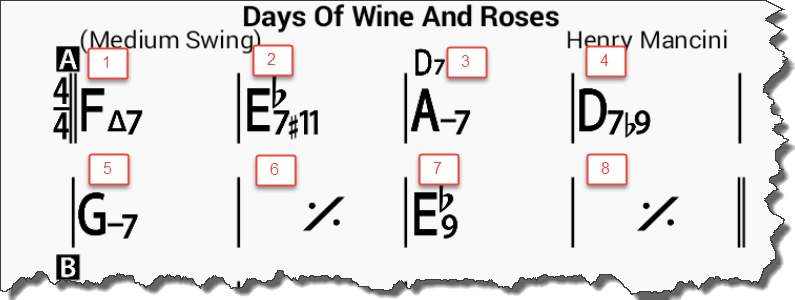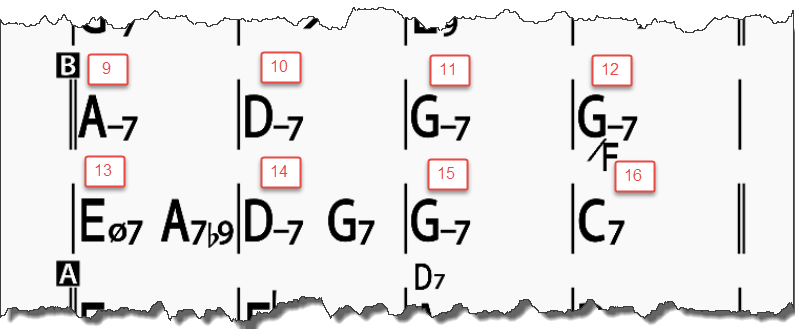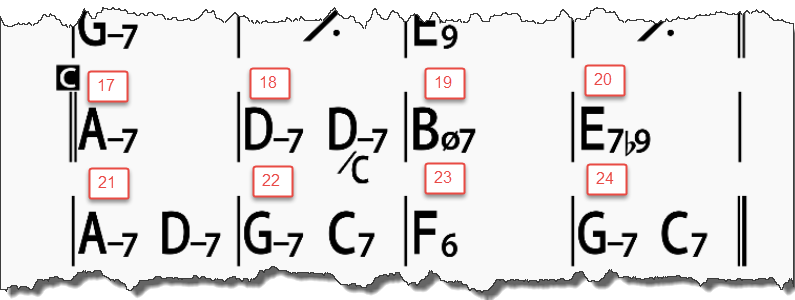Introduction
This post contains a harmonic analysis of the jazz standard, Days of Wind and Roses. Beware though – this is a learning exercise for me so I can’t guarantee the analysis is correct. You’ve been warned.
The first observation to make is that the tune follows a basic A-B-A-C structure that’s 24 measures long, each section consisting of 8 measures.
It seems logical to tackle each section one by one, which I will do below. However, before getting to that I have another basic observation. This tune is in the key of F major. F major is one of the ‘flat’ keys having a single flat note, Bb. Let’s remind ourselves of the notes of F major:
F - G - A - Bb - C - D - E
Now on to the analysis section by section.
‘A’ Section

The ‘A’ section is repeated twice in the overall form (A-B-A-C).
The first chord in the progression is the tonic, Fmaj7. It’s a member of the tonic chord family (obviously).
The second chord is rooted off Eb. This note is not diatonic to the key of F major. In fact it’s a bVII. What we have here is a bVII7, a non-resolving dominant chord. Typically, we regard non-resolving 7#11 chord as being paired with the Lydian Dominant scale, in this case Eb Lydian Dominant. See this post for more on that subject.
So, what’s the relationship between F major and Eb Lydian Dominant? The Lydian Dominant scale is the 4th mode of Bb melodic minor. Bb is diatonic to the key of F major being the 4th degree of the scale but the IV chord is usually a major chord. What has been done here is a common device: taking the major IV chord and making it minor – the minor IV chord.
Using the IV minor key is a common harmonic device in jazz tunes.
NB: the bVII7 chord is often used as a backdoor dominant or as part of the backdoor progression. However, in the ‘backdoor’ scenario the bVII7 chord would generally resolve to the I. That doesn’t happen here. This is a non-resolving dominant chord.
The Amin7 chord in measure 3 is the diatonic iii chord. Like the Fmaj7 this is a member of the tonic family so it still has that tonic flavour. The alternative D7 indicated in the chart allows for semitone root movement from Eb.
In the wider context (measures 3 to 5) we have Amin7 going to D7b9 then to Gmin7. That is a minor secondary ii-V progression to Gmin7. The rules are a bit blurred here; a typical minor ii-V-i progression should have Amin7b5 to D7b9 to any G minor chord but in this case we start with Amin7 (no b5).
The Eb in measures 7 and 8 is the Lydian Dominant again; a bVII7 chord that’s been taken from the IV minor.
‘B’ Section

This section starts with the diatonic iii chord. This is from the tonic chord family, so it’s harmonically similar to the I chord. The same is true of the Dmin7 in measure 10; it’s a diatonic vi chord which is also in the tonic chord family.
That leads to the Gmin7 in measure 11, the diatonic ii chord. Note that in measure 12 there’s a suggestion to put the F in the bass. F is b7 of Gmin7 but by putting it in the bass we add bass movement descending by a tone – which is quite strong – leading to the next chord at the start of measure 13 that’s got an E root. That gives us movement from F to E, descending by a semitone. Strong root movement again.
The next section (Emin7b5 – A7b9 – Dmin7) in measures 13 and 14 is a minor secondary ii-v progression to the vi chord. We continue to back-cycle to the G chord at the end of measure 14.
The chords in measures 15 and 16 (Gmin7 – C7) are simply a standard ii-V that get us back to the I chord (Fmaj7) when section A starts again (i.e. we get Gmin7 – C7 – Fmaj7, a ii-V-I).
An alternative view of measures 14 to 16
Another was of looking at measures 14 to 16 might be to temporarily ignore the Gmin7 in measure 15. If we did that we’d get Dmin7 -> G7 -> C7. We are in the key of F major so the Dmin7 is the vi chord and C7 the V7 chord. So what’s the G7?
Taking a step back again, if we were to use a secondary ii-V progression to get us to the C7 what would those chords be? Well, the secondary dominant of a C chord would be G7 and its related ii chord would be Dmin7. And that’s exactly what we’ve got here. So we could think of this as a secondary dominant ii-V progression, where the secondary dominant is a V/V (‘five of five’).
Note that when we use a V/V the secondary dominant’s ii chord is also the diatonic vi chord! So, Dmin7 -> G7 -> C7 is a vi -> V/V – V7.
Now, butting the G7 up against the C7 is a bit jarring so in this case we soften the progression by slotting in the Gmin7 (the diatonic ii chord) between the G7 and the C7.
‘C’ Section

This section starts with a familiar iii – vi (Amin7 – Dmin7), both tonic family chords, in measures 17 and 18. Note that it’s suggested you play a Dmin7 with a C in the bass at the end of measure 18. C is the b7 of Dmin7 but provides a root movement by a tone downwards again. That next leads to the B root of the Bmin7b5 in measure 19. So, the root note has moved D -> C -> B maintaining strong root movement. Note that B is not diatonic to the key of F major.
The chords Bmin7b5 and E7b9 in measures 19 and 20 give us a minor secondary ii-v to the Amin7 at the start of measure 21 which is followed by the vi chord (Dmin7), another tonic family chord.
In measures 22 and 23 we get a simple ii-V-I in F major (Gmin7 – C7 – F6). The use of an F6 in place of the usual I chord (Fmaj7) drops the 7th in favour of a 6th that adds a 13th flavour to the chord.
F - A - C - E (Fmaj7) F - A - C - D (F6)
Note the root movement in measures 21 to 23 as a whole. We get A – D – G – C – F. That’s strong root movement through the application of back-cycling again.
Measure 24 gives us a quick ii-V that sets us up for a return to the I at the start of section A again. Basically, we have a ii-V-I (Gmin7 – C7 – Fmaj7).
As a final observation about the C-section is that the rate at which we back-cycle in this section is pretty fast. We seem to hurtle down a cascade. This reflects an increase in the harmonic rhythm.

very cool!!!! thanks man!
This is very helpful. thanks